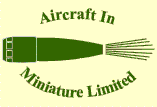Aircraft In Miniature Limited reserve the right to add, alter, or delete parts in their kits or other products
without prior notification in the interests of quality control, production, or product improvement.
Aircraft In Miniature Limited
19 Watling Street, Nuneaton, Warwickshire, CV11 6JJ, England
E-mail: info@aim72.co.uk
Copyright © 2009-2018 Aircraft in Miniature Limited. All rights reserved.


Kits
Emails we have received, together with comments on forums indicate that some modellers do not appreciate how subjects are chosen, the production process or the costs involved.
This page tries to answer some of the questions and is intended to evolve with time. Prices and values given as examples are only valid at the time of writing.
Choosing a subject:
Many models are the result of suggestions we receive - a good example is the B-58 crew steps. Others are of special historical interest, for example the Historic Wings series, while yet others are purely personal choice from association (for example flying in a Cessna 310A - VP-YRP).
Design and production:
To design something using CAD/CAM (Computer Aided Design/Computer Aided Manufacture) involves considerable research and the actual design can take anything from a day to months to complete, depending on complexity. Adding detail is very expensive because of the time involved.
Deciding those features which can be incorporated is important, the best material and most appropriate production method for that part. Research is very time consuming, especially when historic, for example with very old, subjects are involved or if conflicting source data occurs.
Production processes vary and again the result is related to the production methods used. Resin parts can be cast by just pouring into a mould, but these parts often contain bubbles, so casting in a vacuum chamber is a cure for most bubble, although good mould design is important. In the case of white metal or pewter it is possible just to pour into a mould (splash moulding),which often results in poor detail and a lot of flash. We have found centrifugal casting to give the best and most economical results. And then there is vacuum forming - where large moulds are involved a commercial subcontractor is essential, but expensive.
The cost of a model:
I can understand people being horrified by costs, but everything keeps increasing in price and the falling pound can only make matters worse.
Capital equipment costs are also high. To produce a kit as AIM does involves cast resin, cast metal, some vacuum forming and design. Some idea on costs here - a vacuum chamber and pump - £800 to £1,600; centrifugal casting machine and metal heating pot £1,000 to £1,200 and CAD software (excluding computers, scanners or printers) - £15,000, including training. In other words, it isn't cheap. We chose Catia as the design tool because it is the best - if it is good enough for Dassault, Boeing and Airbus it ought to be good enough for our models. There is much more but these examples suffice.
Materials - Resin, styrene and white metal are all expensive and all are constantly increasing - etched metal by 50% in the last two years, with another 6% increase coming in November 2016. white metal prices have risen by 20% in two months. Anything petro-chem based is a well known story.
Finally tooling. Cast metal tooling usually lasts for several hundred casts, but with resin casting the silicone moulds typically have a life of 25 casts, then you must make new moulds. Silicone rubber can typically cost £13 to £18 per kilogram and you can use several kilos per set of moulds. A good example here - we are looking at reissuing the Magna Blackburn Beverly. Silicone for those moulds will cost more than £120 and that will produce 25 kits maximum. Parts are produced using Stereo Lithography (SLA) - as an example we had a quote to produce one 1:72 Argosy main wheel using SLA six years ago and it was £85! Thankfully we have found a much more realistic supplier who we have worked happily with for many years, but again capital equipment costs are high - the MD of the company told me that the laser head alone on their machine costs £30K to replace.
So, when an individual buys a kit (particularly a resin kit) they are not just buying a box of parts, they are amortizing the capital equipment, R&D, design and everything else.
Sadly, to produce unusual subjects to a high standard will always be expensive - you get what you pay for.
I hope that this explains some of the background - it is a very interesting occupation, but without the help of our friends and colleagues at Hannants and around the world this would probably never happen!
Neil Gaunt
28th October 2016